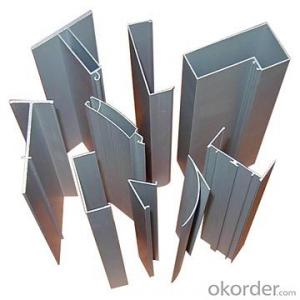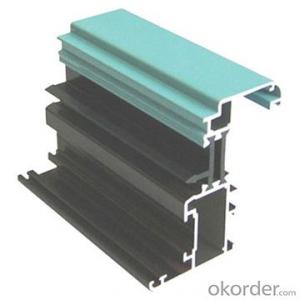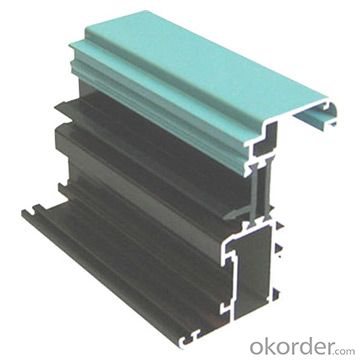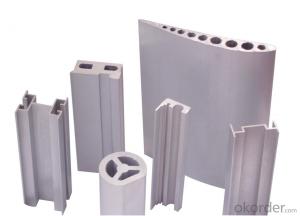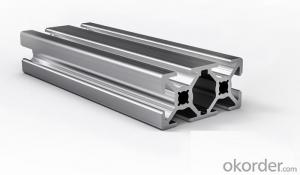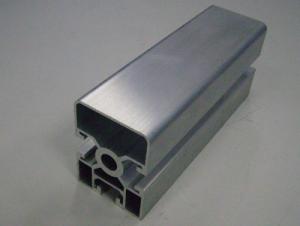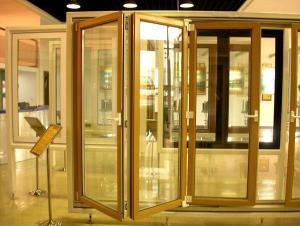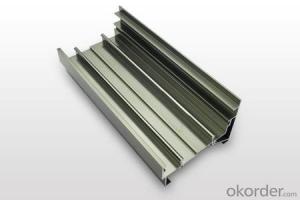Aluminum Tile Trim Profiles for Industrial Extrusion
- Loading Port:
- China Main Port
- Payment Terms:
- TT OR LC
- Min Order Qty:
- -
- Supply Capability:
- -
OKorder Service Pledge
OKorder Financial Service
You Might Also Like
Aluminium is a relatively soft, durable, lightweight, ductileand malleablemetalwith appearance ranging from silvery to dull gray, depending on the surfaceroughness. It is nonmagnetic and does not easily ignite. A fresh film ofaluminium serves as a good reflector (approximately 92%) of visible lightand an excellent reflector (as much as 98%) of medium and far infraredradiation. The yield strength of pure aluminium is 7–11 MPa,while aluminium alloys have yield strengths ranging from200 MPa to 600 MPa. Aluminium has about one-third the densityand stiffness of steel. It is easily machined,cast, drawn and extruded.
Features:
Material | Alloy 6063,6061,6005or according to customer’s choice |
Temper | T3, T4, T5, T6 |
Surface | Anodize, electrophoresis, powder coating, PVDF coating, wood grain painting, matted, etc. |
Length | Coating 6.5 meters, Anodizing 6.5 meters, Mill finish 5 meters |
Application | Industrial, electrical equipment(TV set, air conditioner, refrigerator, computer), decoration,construction, transportation |
Custom Made | We can package following with customer's request. |
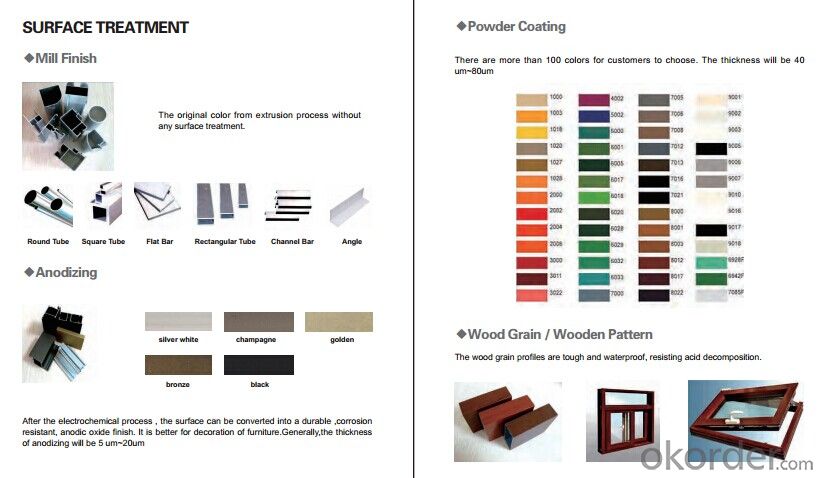
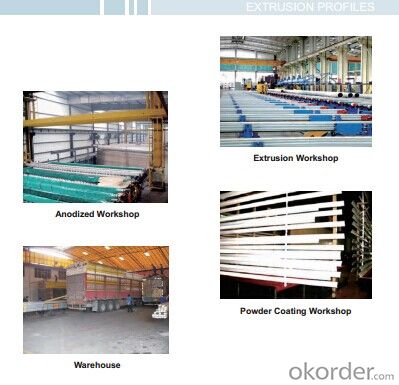
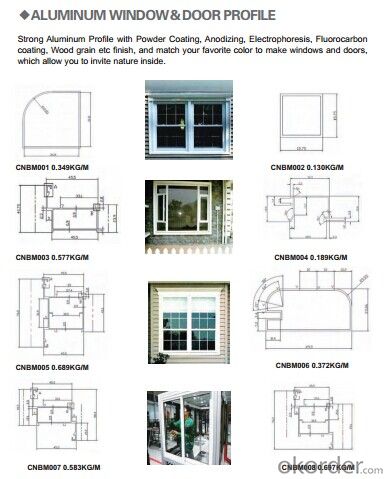
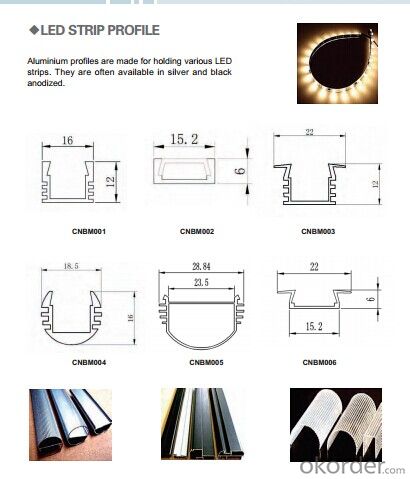
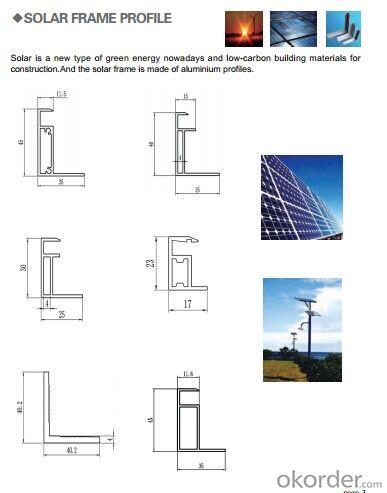
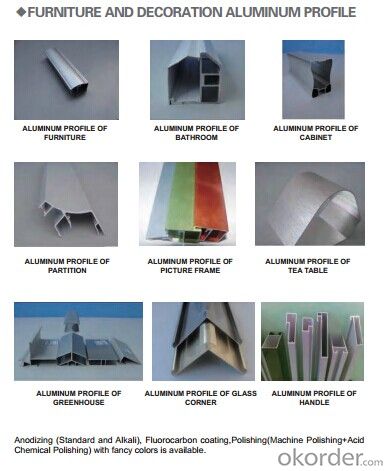
- Q: Aluminum profile connecting piece
- Very little to buy this alone, and only with industrial aluminum suppliers. - selling on Taobao is also a way if the price is appropriate.
- Q: This question asks about the various types of insulation panels that utilize aluminum profiles in their construction.
- <p>Insulation panels made from aluminum profiles come in several types, each with specific characteristics and applications. These include: 1. Sandwich Panels, which consist of two aluminum sheets with a core material like polyurethane, rockwool, or polystyrene. 2. Composite Panels, which combine aluminum with other materials for enhanced properties. 3. Structural Insulated Panels (SIPs), used in construction for their thermal efficiency and strength. 4. Cold Storage Panels, designed to maintain low temperatures in refrigeration units. 5. Acoustic Insulation Panels, which reduce noise transfer. Each type is chosen based on the required thermal, acoustic, and structural performance.</p>
- Q: Are aluminum profiles suitable for use in automotive engine components?
- Yes, aluminum profiles are suitable for use in automotive engine components. Aluminum is lightweight, which helps improve fuel efficiency and reduce emissions. It also has good heat conductivity, allowing for efficient heat dissipation in engine components. Additionally, aluminum profiles offer excellent strength and durability, making them suitable for withstanding the demanding conditions of an automotive engine.
- Q: What is the price of fluorocarbon coated aluminum profiles, please?
- I don't know what kind of series you needBy the tonAluminum ingot price + fluorocarbon spraying priceThe price of aluminium ingot is about 15000RMB/T nowFluorocarbon three coated roughly 20000RMB/T.The so-called series profiles are just its widthHow many tons of materials are used in a specific project?The density of aluminum is 2700KG/m3With aluminum, but also processing costsWhen purchasing aluminum materials, the packing accounts for 3~5%. of the total aluminum material. Do you see kraft paper or plastic film packaging?
- Q: Are aluminum profiles capable of being tailored to fit the unique specifications of a construction project?
- <p>Yes, aluminum profiles can be customized to meet specific requirements of a building project. They offer versatility and flexibility, allowing for adjustments in size, shape, and design. Manufacturers can produce aluminum profiles with varying thicknesses, lengths, and finishes to suit the project's structural and aesthetic needs. Customization may include specific bends, cuts, or holes to ensure compatibility with other building components. This adaptability makes aluminum profiles a popular choice for various construction applications, from window frames to structural supports.</p>
- Q: Are aluminum profiles resistant to mold or mildew?
- Yes, aluminum profiles are resistant to mold or mildew.
- Q: What are the top 20 Chinese architectural aluminum profiles?
- 14, Fujian public security Aluminum Co. Ltd.15, Zhejiang pillars of new material Limited by Share Ltd16, Lear aluminum industry Limited by Share Ltd17 、 Ming emperor Aluminum Industry Co., Ltd.18, Guangdong silver100 innovation Aluminum Co. Ltd.19 、 Qingyuan Asia Aluminum Co., Ltd.20 、 Guanghan Sichuan Sanxing Aluminium Industry Co., Ltd.
- Q: Is it possible to recycle aluminum profiles through the current recycling systems in place?
- <p>Yes, aluminum profiles can be recycled using existing recycling programs. Aluminum is one of the most recycled materials globally due to its non-toxic nature and the energy efficiency of recycling it. Most recycling programs accept aluminum, and aluminum profiles can be collected, sorted, and processed to be melted down and reused in new products. It's important to check with local recycling facilities to understand their specific guidelines and requirements for recycling aluminum profiles.</p>
- Q: How to identify and distinguish the inferior aluminum profile and the poor aluminum profile four?
- The first price, whether manufacturers?.Poor quality of aluminum profileExtrusion defects. Is the extrusion process mature and suitable for operation?.Thin oxide film. Not less than 10um. Aluminum factory, production license, certificate of inspection.Unqualified chemical composition. The unqualified chemical composition seriously endangers the safety of building engineering.Reduce profile wall thickness. 90 series, the wall thickness is lower, not less than 1.4mm.
- Q: How do you clean and maintain aluminum profiles?
- Here are some straightforward steps to clean and maintain aluminum profiles: 1. Begin by eliminating loose dirt or debris from the aluminum profiles' surface using a soft brush or cloth. 2. Create a cleaning solution by combining warm water with mild dish soap or a non-abrasive cleaner. Avoid using harsh chemicals or abrasive cleaners since they can harm the aluminum finish. 3. Immerse a gentle cloth or sponge into the cleaning solution and delicately scrub the aluminum profiles, ensuring that all corners and crevices are thoroughly cleaned. 4. Rinse the profiles with clean water to remove any soap residue. You can accomplish this by using a hose or a bucket of water. 5. Dry the aluminum profiles entirely using a soft, lint-free cloth. This will prevent the formation of water spots or streaks. 6. For routine maintenance, you can employ a specialized aluminum cleaner or polish to restore the shine and safeguard the surface. Follow the product instructions for optimal outcomes. 7. It is crucial to refrain from using abrasive scrubbers, steel wool, or harsh chemicals as they can scratch or damage the aluminum finish. Additionally, never apply acidic cleaners or vinegar on aluminum since they can cause corrosion. 8. If you happen to notice any scratches or minor damages on the aluminum profiles, you can employ a touch-up paint specifically designed for aluminum to repair them. Follow the manufacturer's instructions for application. Always remember that regular cleaning and maintenance will aid in preserving the appearance and longevity of your aluminum profiles.
Send your message to us
Aluminum Tile Trim Profiles for Industrial Extrusion
- Loading Port:
- China Main Port
- Payment Terms:
- TT OR LC
- Min Order Qty:
- -
- Supply Capability:
- -
OKorder Service Pledge
OKorder Financial Service
Similar products
Hot products
Hot Searches
Related keywords
